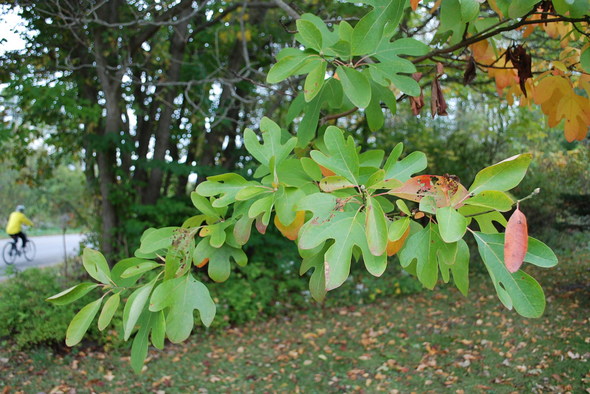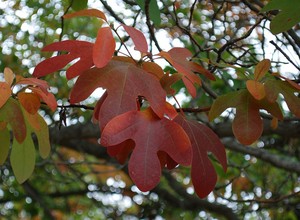Ann Arbor Native: Sassafras has an identity problem

The multiple looks of Sassafras (Sassafras albidum) along Huron River Drive
Rick Meader | Contributor

Sassafras albidum shows some of its colors
Rick Meader | Contributor
First, the name. Almost as fun to say and spell as Mississippi, the name sassafras is supposedly a corruption of the word saxifrage in the 16th century by the Spanish botanist Monardes. I had thought it was a Native American word, and actually am a little disappointed to learn this, but Wikipedia and Botanical.com don’t lie. Sassafras (Sassafras albidum) is a member of the Lauraceae (or Laurel) family, so it is related to bay trees, spicebush and cinnamon trees, among others. It is normally found at heights between 15-50 feet, but you may find clusters of smaller trees that appear almost shrub-like.
You can also find the occasional behemoth. There are two sassafras trees in the Nichols Arboretum Appalachian Glen which are about 24 inches or so in diameter and stretch to the top of the canopy. The Michigan Big Tree, in Berrien County, has a diameter of 133 centimeters (52 inches) and is 27 meters (85 feet) tall.
How about those leaves? Perhaps the most endearing feature of sassafras is its leaf. A single tree may have leaves oval shaped with no lobes, with two lobes or three. If you crush them, you get a pleasant scent. Right about now, they turn beautiful shades of yellow, pink, red or orange. Of course, most people have at least heard of sassafras tea, or have made their own by boiling the plant’s roots. I did this as a kid, and found the tea tastes a bit like root beer. In fact, sassafras has many more uses than just tea. It is also used to flavor candy, tobacco, medicines, soap and, of course, root beer.
Scientific studies found that when sassafras with high levels of safrole was fed to lab animals, they developed liver damage or even cancer, so sassafras with safrole removed is now used for various products. Historically, Native Americans used it for a multitude of uses including treatments for cold, sore eyes, venereal diseases and “overfatness.”
Sassafras albidum is native to all of the Eastern United States and Ontario, Canada. There are two other species of sassafras (in China and Taiwan) and one extinct species as well. It isn’t just a useful plant to humans. Wildlife uses it as well. It is a host (along with Spicebush) of the Spicebush Swallowtail butterfly. Deer, rabbits, groundhogs and black bears eat its leaves, rabbits eat its bark, and a slew of birds including grouse, wild turkeys, flickers, woodpeckers and thrushes eat its fruit.
If you want to include it in your yard, your best bet is to buy a container-grown plant from a nursery as it is not easily transplanted. It prefers dry to mesic soil conditions, and sunny settings. It is shade-tolerant as a youngster, but needs sun to grow. It’s a fun tree, and will add a great deal to your landscape if you choose.
Blooms in my yard are becoming increasingly rare, but still holding on are smooth aster, heart leaf aster, calico aster, white snakeroot and bluestem goldenrod.
Get out and enjoy the natural color, everyone!
Rick is a local landscape architect with a special interest in all things natural, including native plants and the critters that eat them. You can contact him at yourland1824@gmail.com.


Comments
suem
Tue, Oct 26, 2010 : 4:58 p.m.
You can also make file powder (think gumbo) by pulverizing the leaves. Spring or summer is best.